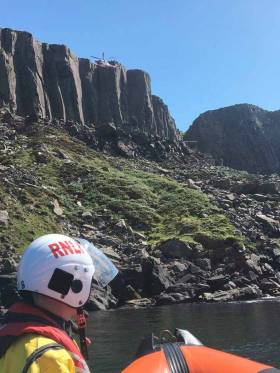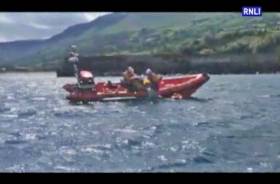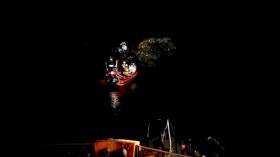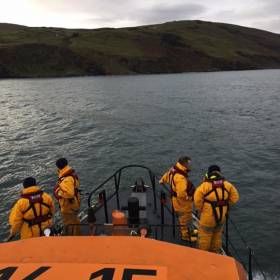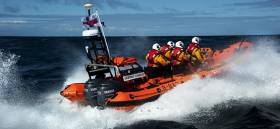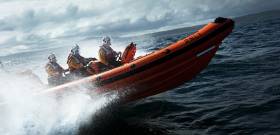Displaying items by tag: Red Bay
Red Bay RNLI Assist in Search for Two Missing Climbers on Fair Head
Red Bay RNLI all weather lifeboat launched last night (Saturday 2 September) at 10.10pm to assist in locating two missing climbers on Fair Head near Ballycastle. A Coastguard rescue helicopter from Scotland was also requested to join the search. Conditions at the time were described as stormy with force six winds on scene.
The two men were successfully located about fifteen metres up the steep rock face and winched on board the helicopter. The Red Bay lifeboat stood by during the extraction of the two casualties off the rock to illuminate the scene with powerful search lights.
The volunteer lifeboat crew returned to station shortly after midnight.
Commenting on the callout Red Bay RNLI Coxswain Paddy McLaughlin said, ‘ Thankfully the two walkers were located very quickly last night as sea conditions were quite poor in the area. The quick extraction of the walkers was aided by the powerful search light of the Red Bay all weather lifeboat and the two men did not suffer any injuries.’
‘Fair Head is a popular area for walkers but people need to take proper precautions. The terrain is extremely rocky and in a fading light can be quite challenging with walkers getting caught out and liable to get stranded or into difficulty.
#RNLI - Red Bay RNLI rescued a woman who fell while climbing Fair Head in Co Antrim yesterday afternoon (Wednesday 12 July).
The volunteer crew launched their inshore lifeboat around 2pm following a request from Belfast Coastguard to go to the scene north-east of Ballycastle.
The shore-based Ballycastle Coastguard rescue team also made their way to the location, while the coastguard helicopter from Prestwick was additionally tasked.
Weather conditions at the time were described as good, with sunny weather and calm seas.
Once on scene, the lifeboat transferred two of its crew members who went ashore to assess the casualty, who had sustained a leg injury.
The crew then began to administer casualty care and worked to reassure the injured woman until the arrival of a paramedic from the rescue helicopter.
The woman was airlifted to Belfast City Airport and transferred to the Royal Victoria Hospital for treatment.
Speaking following the callout, Red Bay RNLI volunteer lifeboat press officer Paddy McLaughlin said: “We would like to wish the woman a speedy recovery from her injury and thank our colleagues in the coastguard who we worked with to bring her to safety.
“As the summer continues, we want to encourage the public to enjoy everything the coast has to offer but we want them to come home safely.
“Fair Head is a popular spot for climbers but it is remotely located and can be challenging so walkers and hikers alike need to go prepared with the right clothing, equipment and training and take extreme care.
“We would remind anyone planning a trip to or near the sea to respect the water and be wary of all edges around the sea. Always let someone know where you are going and when you expect to be back.
“Always carry a means of communication and should you get into difficulty use it to call 999 or 112 and ask for the coastguard.”
#RNLI - The volunteer lifeboat crew with Red Bay RNLI rescued two kayakers yesterday afternoon (Saturday 17 June) after their vessel capsized near Waterfoot in Co Antrim.
The alarm was raised at 3.33pm when a member of the public heard two men shouting for help after their kayak upturned and they were blown out to sea.
The Red Bay inshore lifeboat was immediately requested to launch by Belfast Coastguard and the lifeboat crew were quickly on scene.
As they arrived, the lifeboat crew saw the two men in the water clinging to an upturned kayak. They immediately recovered them onto the lifeboat and brought them safely ashore.
Commenting on the callout, Red Bay RNLI helm Paddy McLaughlin said: “It was a beautiful day on the Antrim coast and many people took to the water. These men were very lucky their calls for help were heard and that the lifeboat crew were on scene so quickly.
“We would advise everyone enjoying the water during the warm weather to take all necessary safety precautions including wearing a suitable flotation device and having a means of calling for help.”
Red Bay RNLI Rescues Fisherman Trapped After Fall From Rocks
Red Bay RNLI in County Antrim rescued a fisherman in the early hours of this morning (Saturday 10 June) after he fell and became trapped between rocks near Glenarm Marina.
The volunteer crew was requested to launch both their all-weather and inshore lifeboats shortly before 2.30am at the request of Belfast Coastguard. The Coastguard unit from Larne was also tasked.
The all-weather lifeboat under Coxswain Charles Stewart and the inshore lifeboat helmed by Paddy McLaughlin immediately launched into the darkness and made their way to the scene.
Weather conditions at the time were poor with rain leading to low visibility, a moderate sea and a Force 4 south easterly wind blowing.
The fisherman who had been fishing off rocks near Glenarm Marina got into difficulty when he fell down between large rocks and became wedged. His girlfriend raised the alarm.
Once on scene, the lifeboat crew observed that the man was trapped in an isolated area among large boulders.
The inshore lifeboat crew proceeded to the casualty and immediately began to work to free the fisherman before administering casualty care.
The man was then successfully placed on a stretcher and transferred to the lifeboat and taken to the nearby marina and into the care of the ambulance service.
Speaking following the call out, Paddy McLaughlin, Red Bay RNLI Volunteer Lifeboat Press Officer said: ‘We would like to wish the fisherman a speedy recovery following what must have been a frightening ordeal for him early this morning. This was a particularly challenging call out as the casualty fell in an isolated area where there are a lot of large boulders and so extraction could only be done by sea. There was a real team effort involved with our crews on both the inshore and all-weather lifeboat working closing together with our colleagues in Larne Coast Guard to bring the man to safety.
‘We would remind anyone planning any activity near or at sea this summer, to always respect the water. Go prepared for the weather conditions and always carry a means of calling for help should you get into difficulty. Always let someone on the shore know when and where you are going and when you are due back.’
Red Bay Lifeboat Rescues Three Off Glenarm
#RNLI - Red Bay RNLI’s lifeboat was launched yesterday afternoon (Sunday 5 February) to locate and rescue three people on board a 13ft boat off Glenarm Bay.
The lifeboat crew located the vessel, which had suffered engine failure, three miles east of Glenarm Marina.
Two people on board the boat were transferred to the lifeboat before the vessel was taken in tow to Glenarm.
The three men were on a fishing trip and contacted Belfast Coastguard by mobile phone to raise the alarm. Sea conditions were calm with freezing temperatures.
Around the same time, the volunteer lifeboat crew at Crosshaven RNLI in Cork Harbour launched to assist a grounded yacht.
On arrival, the lifeboat transferred a crew member to the yacht and made good a towline. Before the tow commenced the yacht's integrity was checked.
After successfully towing the vessel into deep water, another check for leaks was made before the yacht and its crew were happy to make their own way to East Ferry.
Red Bay Lifeboat Joins Search For Missing Person
#RNLI - Volunteers from Red Bay RNLI in Co Antrim joined in the ongoing search for a missing woman yesterday (Sunday 18 December).
The all-weather lifeboat, under coxswain Paddy McLaughlin and with six crew members onboard, launched at 11.30am and continued searching until 6pm yeserday evening.
The lifeboat started its search in the area of Ballintoy before moving south to Torr Head. Coastguard units meanwhile searched the shoreline.
Weather conditions were favourable with a cold but moderate sea and good visibility.
“We searched in good conditions for most of today but unfortunately we didn’t find anything,” said McLaughlin.
“Our thoughts remain with the lady’s family during an ongoing search.”
Elsewhere, the volunteer lifeboat crew at Larne RNLI responded to a launch request from the UK Coastguard yesterday morning.
The initial alarm was raised by a concerned member of the public who reported seeing a person signalling to shore from a fishing vessel around 1.5 nautical miles off Glenarm.
Larne RNLI’s all-weather lifeboat launched at 10.45am and quickly made its way to Glenarm. The lifeboat crew made radio contact with a fishing vessel in the area who confirmed they did not require any assistance.
The surrounding area was searched to ensure there were no other vessels nearby. The lifeboat was returned to Larne after it was established as a false alarm with good intent.
Speaking following the callout, Larne RNLI coxswain Frank Healy said: “We thank this vigilant member of the public who called the coastguard out of genuine concern.
“We would urge anyone who is concerned that someone is in distress along our coast to always ring 999 and ask for the coastguard. We would always rather launch to a false alarm with good intent than not launch at all.”
Larne RNLI will host its annual icebreaker swim at 12 noon on New Year’s Eve at Ballygally Beach.
The lifeboat station is asking people to 'Get freezin' for a reason' this New Year’s Eve, with all money raised going to the RNLI to help save lives at sea.
Anyone interested in taking part can obtain a sponsor form by contacting 07516 496945 or the station’s Facebook page, or collect on the day.
Hot refreshments will be available at the Ballygally community centre following the swim.
Red Bay RNLI Rescues Man After Fall From Wall in Cushendall
Lifeboat crew from Red Bay RNLI rescued a man who fell over a wall sustaining multiple injuries in the early hours of this morning (Sunday 31 July).
The man who fell at 2.30am landed close to rocks beside the lifeboat station in Cushendall. A community action plan was quickly was put into action and the lifeboat crew was paged to provide first aid.
Crew members along with an off-duty paramedic were quickly on scene where they assessed the casualty who had suffered a broken thigh.
Using the station’s first aid pack complete with oxygen and Entonox, the lifeboat crew worked with the paramedic in challenging conditions to stabilise the man and stretcher him to the lifeboat station in an operation lasting over an hour.
The man was later transferred by ambulance to the Causeway Hospital in Coleraine.
Speaking following the incident, Paddy McLaughlin, Red Bay RNLI Volunteer Lifeboat Press Officer said: ‘The man was very unfortunate to fall where he did last night and we would like to wish him a speedy recovery from his ordeal.
‘This was a great example of a community working well together to come to someone’s aid. Many will associate Red Bay RNLI with the water but this incident proved how having people with the right skills and training with the essential first aid equipment including oxygen and Entonox, can rescue someone in need.
This was the second incident that Red Bay RNLI responded to this weekend. On Saturday evening just before 6pm, the lifeboat crew was requested to launch their inshore lifeboat after a member of the public spotted two canoeists who they thought to be in trouble in the Murlough Bay area near Fair Head which is known to be dangerous.
Arriving on scene, the lifeboat crew checked the canoeists were safe and well before allowing them to continue unaided.
#RNLI - Red Bay RNLI was paged at 6am this morning (Wednesday 20 July) to go to the aid of a 40ft yacht, with two people on board, after the vessel suffered engine failure and was unable to move.
The sailors were on passage from Scotland to Isle of Man when they got into difficulty some three miles east of Red Bay in Co Antrim.
With dense fog in the area, Belfast Coastguard requested the launch of the Red Bay all-weather lifeboat to tow the vessel to safety – and all safely arrived into Cushendall by 8.30am.
Red Bay RNLI Get All-Weather Lifeboat for Two Year Trial
An all-weather lifeboat has officially been put on service and become a declared search and rescue asset for a two year trial period at Red Bay RNLI in County Antrim.
The Trent class lifeboat Henry Heys Duckworth has come from the existing RNLI fleet and will now operate alongside the station’s existing inshore lifeboat.
Prior to its arrival in Cushendall, the lifeboat was moored at Glenarm Marina for a short period to facilitate the completion of shore works at Red Bay.
Today’s fully operational status for the all-weather lifeboat follows an intensive period of training for the station’s volunteer crew members.
The Henry Heys Duckworth was first launched in 1996 and since then has launched 200 times and rescued 217 people.
The decision to place an additional all-weather lifeboat on the North Antrim coast follows an in-depth review by the RNLI, of lifeboat cover in Northern Ireland.
Since the announcement last May there has been a concentrated period of preparation for the lifeboat crew, which has included months of training and visits to the RNLI College in Poole.
There are currently five coxswains, four mechanics, four navigators and a group of all-weather lifeboat crew members trained and ready to respond to call outs aboard the Henry Heys Duckworth.
Last year, Red Bay RNLI launched 20 times and brought 18 people to safety. Of those launches, 11 services were in the dark. In all, some 160 service hours were spent at sea.
Speaking as the lifeboat officially went on service this morning, Andrew McAlister, Red Bay RNLI Lifeboat Operations Manager said there was great excitement within the Cushendall community: ‘This is a proud day for everyone involved with Red Bay RNLI. The new lifeboat will allow us to provide lifesaving cover in all weathers and in challenging conditions up to 100 miles off the North Antrim coastline. To see this group of volunteers coming together and training with the all-weather lifeboat in recent months was wonderful and we are now fully prepared and equipped with the necessary training and skills to respond operationally alongside our inshore lifeboat.’
Developed by the RNLI in the early 1990s, the Trent class lifeboat is designed to lie afloat and is inherently self-righting. At sea, it is crewed by six all-weather lifeboat volunteers. It is capable of 25 knots and can carry up to 73 survivors.
The Trent carries an XP boat, an inflatable daughter boat with a 5hp outboard engine capable of six knots. She is used to access areas where the lifeboat cannot reach.
The comprehensive electronics include VHF and MF radios with DSC functionality, VHF direction finder, DGPS with electronic chart system and radar. Comprehensive first aid equipment includes stretchers, oxygen and entonox. Other equipment includes a portable salvage pump carried in a watertight container.
Five RNLI Lifeboats Involved in Search for Missing Microlight Aircraft off Northern Ireland Coast
Five RNLI lifeboats were launched last night from Larne and Red Bay in Northern Ireland and Portpatrick in Scotland to take part in an extensive search for a missing microlight aircraft. The craft is understood to have two people onboard when it was reported missing off the Northern Ireland coastline.
The launch was requested by the coastguard when the aircraft was reported overdue at 8.30pm and a major search operation was put in place.
Joining the five RNLI lifeboats in the major search were the Irish Coast Guard Helicopter Rescue 116 along with a rescue helicopter from Prestwick and local coastguard teams.
Search conditions were described as extremely challenging as visibility was poor due to thick fog. Larne RNLI launched their all-weather lifeboat and D class lifeboat, Red Bay RNLI launched their Atlantic 85 and all-weather lifeboat along with the all-weather lifeboat from Portpatrick. The lifeboats between them searched a huge area off the Northern Ireland coastline before standing down the search after 4am. It is expected that the search will resume again this morning; however weather conditions remain poor with heavy fog still present.
UK Coasguard adds
At about 8.30pm yesterday (Thursday 9 June) Distress and Diversion (based at Swanwick) notified the UK Coastguard that a small microlight aircraft with two persons on board had been reported overdue.
The microlight was transiting the Northern Ireland coastline when it went missing and an extensive search is being carried out in the area.
Last night and in the early hours of this morning, the UK Coastguard search and rescue helicopter based at Prestwick, the Irish Coastguard helicopter based at Dublin, Ballycastle, Coleraine, Stranraer, Portpatrick, Larne and Campbelltown Coastguard Rescue Teams, Larne RNLI inshore and all weather lifeboats, Red Bay inshore and all weather lifeboats and Portpatrick RNLI all weather lifeboats, were all involved in the search.
The search was suspended due to poor visibility as a result of fog at 3.00am today (Friday 10 June). The teams and rescue units are waiting for the visibility to improve before they resume the search.
The Northern Ireland North West Mountain Rescue Team will also be joining the search today.
Ryan Gray, Senior Maritime Operations Officer at the UK Coastguard said: ‘UK Coastguard has also issued a Mayday relay broadcast in the area and several merchant shipping vessels have responded and are keeping a lookout for this aircraft. We may send further resources as the search widens.’
The Northern Ireland Police and Police Scotland have also been informed.
A further update will be provided when the search resumes.




























